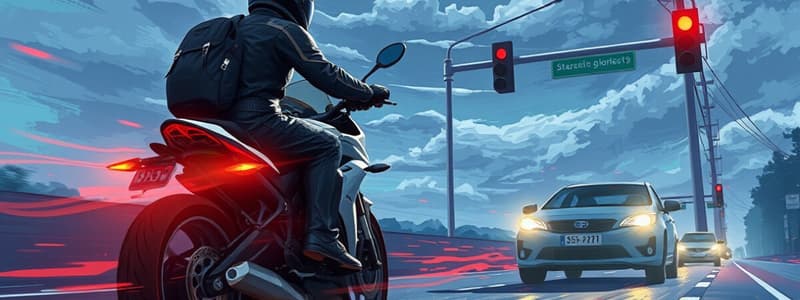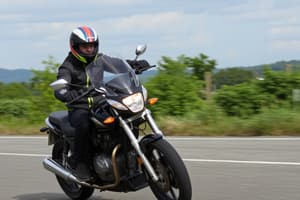Podcast
Questions and Answers
Motorcycles present more risk than cars or trucks due to issues with:
Motorcycles present more risk than cars or trucks due to issues with:
- Stability
- Vulnerability
- Visibility
- All of the above (correct)
Compared to other drivers, motorcyclists are more vulnerable to:
Compared to other drivers, motorcyclists are more vulnerable to:
- Weather
- Roadway Debris
- Other vehicles
- All of the above (correct)
For greater security when parked:
For greater security when parked:
- Both A and B (correct)
- Put motorcycle in first gear to prevent rolling
- Lock the forks
Good skills alone will not keep you from crashing but good ___________ can:
Good skills alone will not keep you from crashing but good ___________ can:
What label indicates that a helmet has met the minimum U.S. performance standards?
What label indicates that a helmet has met the minimum U.S. performance standards?
Research indicates almost 45% of impacts to the head in crashes occur in the jaw and face area.
Research indicates almost 45% of impacts to the head in crashes occur in the jaw and face area.
Helmets are designed to absorb energy that would otherwise be transmitted directly to your _______.
Helmets are designed to absorb energy that would otherwise be transmitted directly to your _______.
Which equipment provides adequate eye protection for motorcycles?
Which equipment provides adequate eye protection for motorcycles?
Sturdy over-the-_____ boots are recommended for motorcycling.
Sturdy over-the-_____ boots are recommended for motorcycling.
Select riding gear with these three things in mind:
Select riding gear with these three things in mind:
Dress in ______ to stay comfortable in changing conditions.
Dress in ______ to stay comfortable in changing conditions.
Avoid riding when:
Avoid riding when:
The cause of most single vehicle motorcycle crashes is rider _____.
The cause of most single vehicle motorcycle crashes is rider _____.
Foot operated controls include:
Foot operated controls include:
The area of clutch travel where power begins to transmit to the rear wheel is known as the _______ ____.
The area of clutch travel where power begins to transmit to the rear wheel is known as the _______ ____.
How many steps are included in the basic cornering procedure?
How many steps are included in the basic cornering procedure?
Turn your head and look at the ground when turning a motorcycle.
Turn your head and look at the ground when turning a motorcycle.
When shifting, a rider should:
When shifting, a rider should:
Use only the rear brake for routine stops.
Use only the rear brake for routine stops.
One key to successful street riding is the ability to search out potential hazards and anticipate their consequences.
One key to successful street riding is the ability to search out potential hazards and anticipate their consequences.
SIPDE is a strategy for:
SIPDE is a strategy for:
________ is an aggressive purposeful search for information.
________ is an aggressive purposeful search for information.
In the Decide and Execute stages of SIPDE, a motorcyclist may do what to avoid danger?
In the Decide and Execute stages of SIPDE, a motorcyclist may do what to avoid danger?
______ ________ may cause you to run into the object on which you're focused.
______ ________ may cause you to run into the object on which you're focused.
Motorcycles with adequate mirrors do not have blind spots.
Motorcycles with adequate mirrors do not have blind spots.
The 3-second minimum following distance provides:
The 3-second minimum following distance provides:
Where do most multi-vehicle motorcycle crashes occur?
Where do most multi-vehicle motorcycle crashes occur?
A driver who makes eye contact with a motorcyclist has seen them.
A driver who makes eye contact with a motorcyclist has seen them.
The basic turning procedure is:
The basic turning procedure is:
Many crashes involve riders who enter curves too ____.
Many crashes involve riders who enter curves too ____.
The outside-inside-outside cornering path increases line-of-sight and creates a curve that is less sharp.
The outside-inside-outside cornering path increases line-of-sight and creates a curve that is less sharp.
Flashcards are hidden until you start studying
Study Notes
Motorcycle Risk Factors
- Motorcycles pose higher risks than vehicles due to stability, vulnerability, and visibility issues.
- Motorcyclists are more susceptible to challenges from weather, roadway debris, and other vehicles.
Safety and Security
- To secure a parked motorcycle, lock the forks and put it in first gear.
- Good judgment is essential for preventing crashes, as skill alone is insufficient.
Helmet and Protective Gear
- Look for the DOT label to ensure a helmet meets U.S. performance standards.
- Helmets protect the head by absorbing impact energy.
Eye Protection
- Face shields provide adequate eye protection for motorcyclists.
Riding Gear
- Sturdy over-the-ankle boots and layered clothing are recommended for comfort in varying conditions.
- Prioritize protection, comfort, and visibility when selecting riding gear.
Riding Behavior
- Avoid riding when fatigued, stressed, or preoccupied, as these factors significantly increase risk.
- Most single-vehicle motorcycle crashes are attributed to rider error.
Motorcycle Controls
- Foot-operated controls do not include throttle, clutch, or front brake.
- The clutch's initial engagement area is known as the friction zone.
Cornering and Shifting
- Basic cornering involves a four-step procedure.
- While shifting gears, riders must roll off the throttle, squeeze the clutch, and operate the gearshift lever.
Hazard Awareness
- Successful street riding involves anticipating potential hazards and their consequences.
- SIPDE stands for making sound judgments regarding road conditions.
Scanning and Situational Awareness
- Scanning is crucial for proactive information gathering while riding.
- In the Decide and Execute stages of SIPDE, riders can adjust speed, position, and communicate to avoid danger.
Target Fixation and Blind Spots
- Target fixation can lead to collisions with the object of focus.
- Motorcycles equipped with adequate mirrors may still have blind spots.
Following Distance and Crash Statistics
- Maintaining a minimum of three seconds of following distance allows time to react and maneuver safely.
- Most multi-vehicle motorcycle crashes occur at intersections.
Misconceptions and Riding Techniques
- Making eye contact with a motorcyclist does not guarantee that the driver has seen them.
- The basic turning technique is composed of "Slow, Look, Roll, Press."
- Riders often enter curves too quickly, which can lead to accidents.
Cornering Path
- The outside-inside-outside cornering method enhances line-of-sight and makes for a smoother turn.
Studying That Suits You
Use AI to generate personalized quizzes and flashcards to suit your learning preferences.




